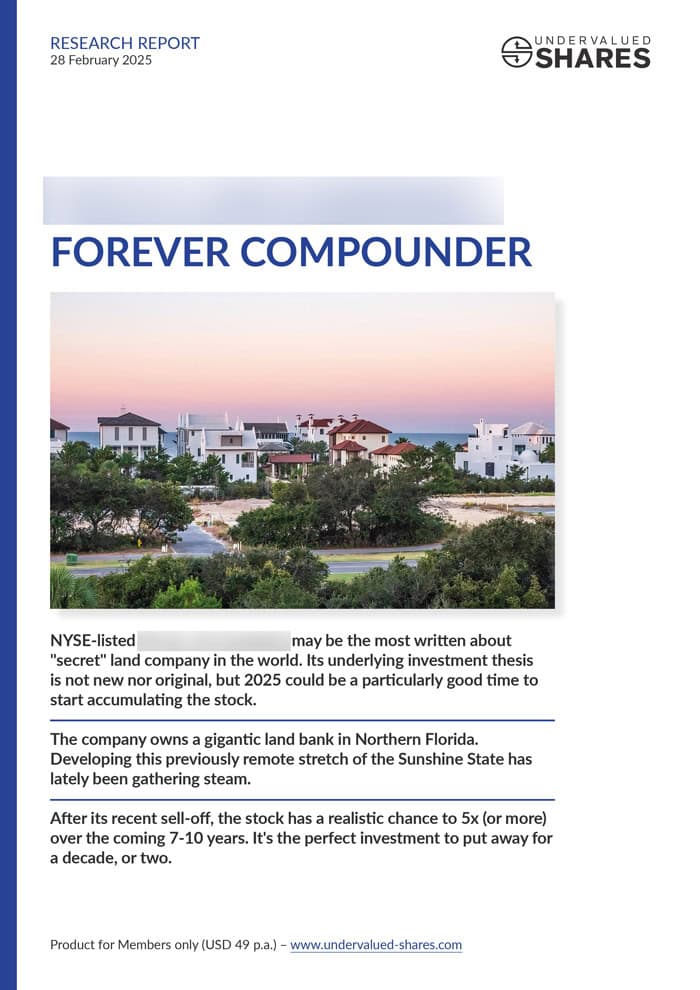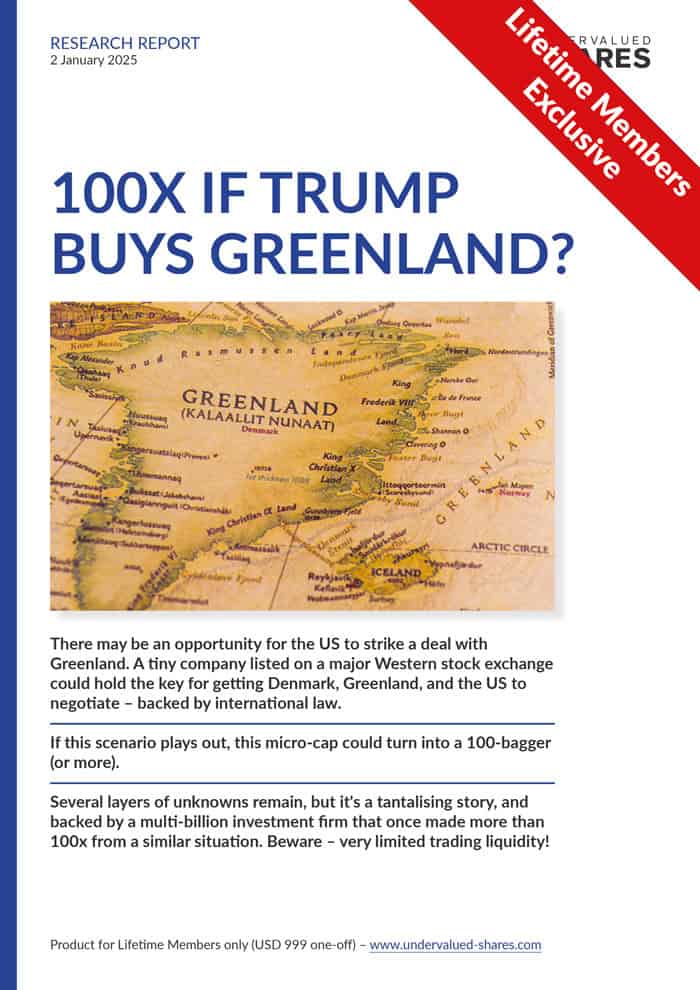I turn 50 today. What have I learned about investing so far?
Argentinean money lessons – Germany, take note!
It’s high summer in Argentina, and locals love taking a stroll along the riverfront of Puerto Madero, the glitzy new district built in Buenos Aires’ formerly derelict Eastern harbor area. The promenade offers ice cream galore for kids, ample space for dogs to run free, and plenty of pitstop-style bars where adults can cool down over an ice-cold beer.
Foreign visitors to the district, like your author, could easily forget they are in a crisis-stricken country. Offices and residential properties are built in the latest architectural styles; trendy boutique hotels are neighboring with established luxury chains like Hilton, and many of the Starbucks cafes and similar venues are as clean, new and nice as they come.
It was a display ad along the cobble-stoned riverfront path that rudely reminded me that even in this seemingly privileged enclave of the country’s capital, Argentina currently is no ordinary country by anyone’s standard.
Loosely translated, the ad read:
“Time limited offer: 25% interest p.a. – now available at your HSBC Bank pop-up branches on Saturdays and Sundays only in the two local luxury shopping malls.”
At first, I wasn’t even able to make full sense of the ad.
Hadn’t I recently read that Argentina’s inflation rate was running (literally) at 70% p.a.?
Was that 25% interest on deposits, or for taking out a loan?
How would these numbers ever stack up?
Stepping closer to read the fine print of the ad, it all started to make sense. The ad was for placing deposits with the bank, but it was eight months old and had come out at a time when the country’s inflation rate had “only” been 25.6% p.a.
Which taught me not one, but two things:
- Savers across the world get screwed if they rely on the financial industry. Even when the ad was current, it effectively represented an offer for a negative 0.6% p.a. interest rate. Pursue the old-fashioned virtue of putting money aside when times are good, and the financial sector will punish you for doing so. Saving is bad, debt is good. We live in crazy times!
- Once a financial crisis breaks out, it moves so fast – and so far – that it’s virtually impossible to keep up. An inflation rate going from 25.6% p.a. in March to 70% p.a. in October is too rapid a change for anyone to stay on top of things. Given Argentina’s rapid descent into an inflationary crisis, HSBC had probably simply given up on even trying to keep up with the situation. In times of deep crisis, everyone just buckles down and tries to survive somehow.
Why is any of this relevant for you, given that this is unfolding in a comparatively minor country situated on the outer edge of the civilized world?
Lo and behold, there are lessons to be learned, especially for anyone residing in the seemingly safe countries of Western Europe.
The bigger the hype, the steeper the fall
You may know the old joke question: “How does an Argentinean man commit suicide?”
“By climbing on top of his ego and jumping down!”
To which the German in me would add the old German saying: “Pride comes before fall.” (Hochmut kommt vor dem Fall.)
I don’t even want to talk of the time when Argentina was one of the world’s 10 wealthiest countries. The 1930s are too far in the distant past to make for a good comparison.
However, I do vividly remember the mid-1990s, when Argentina counted as one of the hot, up-and-coming investment destinations. Foreign money was flowing into the country at record pace, as investors from all over the world wanted to get in on the seemingly sure thing of the Argentine renaissance. Argentina felt really good about itself, and so did the people who jumped on the bandwagon.
If only these investors had applied some common sense, instead of listening to economists, vendors of financial products, and the usual range of other so-called “experts.”
By merely applying common sense, those who invested in Argentina at the time could have saved themselves a lot of (financial) pain.
For it’s common sense that still ends up getting it right more often than not.
All the signs were there (even if you were an amateur observer)
By the late 1990s, the country’s debt to foreign investors had ballooned to a figure that was equivalent to 50% of Argentina’s GDP.
If that doesn’t tell you much, here is another statistic that will immediately make sense. At the time, one out of seven dollars flowing from the developed world to third world countries went to Argentina.
Back then, Argentina contributed about 1.5% to the world’s economy. For a country of 30 million people to receive one-seventh of all emerging market investment was outright insane. It was evident that Argentina’s boom was the result of hype and that it had turned into an unsustainable bubble.
As always, no one wanted to listen. After all, it looked good on the surface. What’s more, “experts” gave it the thumbs up.
Most investors who poured money into Argentina during the boom ended up losing about two-thirds of their investment. Some even more, others a bit less.
Incidentally, that’s about the same percentage as the wealth lost by Argentina’s middle class virtually overnight (!) when the country officially went into debt default in late 2001. When the banks closed, and the government declared “Game Over,” most anyone in Argentina who previously counted as middle class lost two-thirds of their wealth and income.
Foreign investors and locals alike shared unprecedented pain, and neither the country nor its people have fully recovered since then. As you can see from HSBC’s ad and the current inflation rate, the crisis down here still rumbles on. Once a country has hit the wall, it often takes 15 to 20 years to get back on track.
Can it happen elsewhere?
Speaking of lessons to be learned from Argentina, in my roughly 25 years of following financial markets, I am amazed by how little most people value common sense when it comes to making their long-term investment allocations.
I am not a trained economist; nor do I necessarily stay on top of every financial detail about a country or a company, and you can hold that against me if you so wish.
What I have come to learn, though, is that it isn’t actually all that important. If you are able to make a common sense-based judgment after taking a 33,000-foot perspective of a subject, you end up being right often enough to make money off it.
Which is why right now, while enjoying the Argentinean sunshine and cheap prices, I regularly shake my head in disbelief about Germany, my former home country that I inevitably keep an eye on because it’s such a significant market stock market and quite simply the biggest economic (and political) factor in Europe.
Germans currently have a lot of reasons to feel like they are on top of the world:
- Relatively speaking, the most successful export economy in the world: Exportweltmeister!
- Germany treasury bonds (Bunds)are considered one of the safest investments in the world.
- The country is the go-to source for money whenever another European country (or the EU itself) requires another shot in the arm.
There is a self-confidence of Argentinean proportions, circa 1998.
To which I then add my concerns about figures that are neither popular nor widely known, but which I count as common sense analysis:
- Some 44 million out of Germany's total population of 83 million are part of the labor force. However, 19 million receive more benefits from Germany’s government than they contribute in taxes while only 25 million are net contributors to the government’s tax income. This figure includes 13 million who are paid a salary by the government in one way or another (teachers, bureaucrats, fire-fighters, etc.). That effectively leaves 12 million people pulling the cart for the other 71 million. Of those 12 million, only 8 million are younger than 45. That sounds like a precariously thin part of the population to me, all the more since the mere passage of time is decreasing that number.
- It’s not unreasonable to say that the country’s national debt can, ultimately, only be serviced and repaid by those who are net contributors to the government’s coffer. Counting both the officially declared national debt as well as the entitlement liabilities in the form of future pension and health insurance claims, if you spread out the national debt across these 8 million Germans, then they each carry a national debt of approximately EUR 250,000 or the equivalent of seven annual pre-tax incomes. Precise figures vary depending on which source you use for debt figures, but in any case, it’s a huge figure.
- Germany is losing a net 80,000 highly qualified people each year, to countries like Switzerland, Australia, and the US. Because of immigration laws in other countries requiring new arrivals to be on the younger side, that’s an annual loss of approximately 1% of the country’s pillar of future productivity. With each one of those super-productive Germans leaving the country, the remaining ones have to be squeezed even harder, which eventually only further accelerates the brain drain.
- Add to all that the country’s hidden liabilities. E.g., since November 2007, the state has also built up so-called “Target 2 balances” of 1 trillion euros by lending money to the likes of Italy and Spain. These are countries that, historically, have not exactly been the most disciplined of creditors. That’s equivalent to about 28% of Germany’s GDP, throwing a big part of Germany’s recent economic growth into question.
These are all just examples, and the number of concerns I could list out about Germany is much longer. Admittedly, for some of them, there are two sides to the coin. E.g., not everyone agrees that “Target 2” is a liability, and instead they call it a “payment system balance that only exists on paper.” Honi soy qui mal y pense.
On the whole, though, common sense indicators show to me, that in Germany, too, pride could come before fall. Looking at some of these figures, the country’s wealth – and the financial well-being of its broad middle-class – seems a lot more vulnerable than it’s often made out to be.
Only, no one currently wants to hear any of that.
However, visiting countries like Argentina teaches you how fast a situation can turn and how deeply a seemingly prosperous country can fall once a tipping point is reached.
Germany, beware!
What you should take from all this
Bill Gates once said that most people over-estimate how much technology can change in one year, but they underestimate how much technology can change in ten years.
The same holds true for investing, economics, and politics.
I am absolutely amazed by the kind of wealth creation and wealth destruction that I have in the space of ten years or twenty years.
That’s why on this website, I increasingly make an effort to find “Big Ideas.” With that, I am referring to trends and investments that I believe can undergo a significant positive change over an extended period. For anyone who doesn’t want to make investing a full-time job, it’s much easier to find a good investment and let it run, instead of continually buying and selling shares.
I've picked the example of Germany to demonstrate that what’s seemingly safe today may carry the risk of a rude awakening in the future. Which is not to say that one shouldn’t invest in Germany (quite the opposite, I may even be featuring a big, well-known German company in my upcoming research reports).
However, start learning to let go of views and ideas that have been a substantial part of your life for very long. The world changes, and whenever something reaches a tipping point, it changes rapidly and steeply! Nothing is set in stone, and we need to remain agile not just physically, but also mentally.
Common sense is often all it takes to be aware of these future tipping points, or at least occasionally be on the right side of them.
Finding and analyzing such upcoming tipping points is what I count among the goals of this website. I want to be able to tell my readers about Big Ideas before they manifest, and how to best make use of them in their own investment decisions.
I’ve got plenty on this coming up in the coming months, so stay tuned!
P.S.: One company where such as long-term “swing” might be in the making is Gazprom, Russia’s biggest gas company. I've just published a 94-page report on the company, which is available to all members of this website. Membership is available for only $49 per year, and I have prepared a short preview of the Gazprom report for you in case you want to find out more.
Did you find this article useful and enjoyable? If you want to read my next articles right when they come out, please sign up to my email list.
Share this post:








